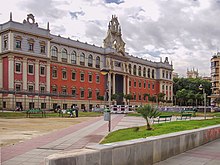University of Murcia
This article's tone or style may not reflect the encyclopedic tone used on Wikipedia. (January 2014) |
 | |
| Latin: Universitas Studiorum Murciana | |
| Type | Public |
|---|---|
| Established | 1272 (original) 1915 (current) |
| Rector | José Orihuela Calatayud |
Academic staff | c. 2000 |
| Undergraduates | c. 30,000 |
| Postgraduates | c. 1500 |
| Address | Avenida Teniente Flomesta, nº 5 , , , 30003 Murcia |
| Campus | Urban La Merced; Espinardo |
| Website | www |

The University of Murcia (Spanish: Universidad de Murcia) is the main university in Murcia, Spain. With 38,000 students, it is the largest university in the Región de Murcia. The University of Murcia is the third oldest university in Spain, after the University of Salamanca (1218 AD) and the University of Valladolid (1241 AD), and the thirteenth in the world. The University of Murcia was established in 1272 by the King Alfonso X of Castile[1] under the Crown of Castile.
The majority of the University's facilities and buildings are spread over two campuses: the older is La Merced, situated in the town centre, and the larger is Espinardo, just 5 km to the north of Murcia. A third campus for Medical and Health Studies is currently[when?] being built next to the suburban area known as Ciudad Sanitaria Virgen de la Arrixaca, 5 km south of the city. A new campus had been made in San Javier too, that hosts the Sports Science faculty.
Facilities


The University of Murcia is an institution devoted to providing higher education to the public. Among its main objectives are the creation, development and research into science, technology and culture through study and research and the transmission of such knowledge through education.
Accordingly, our University enjoys modern facilities located in the different University Faculties and Colleges and the Experimental Science Support Service (SACE).[2] This is located in Espinardo, next to the Faculties of Biology, Medicine, Chemistry and Veterinary Science, and includes services such as laboratory animals, scientific calculations, cultivation of tissues, agricultural and forestry experiments, radio protection and waste, scientific equipment, microscopy, image analysis, and psychology equipment, as well as research support laboratories.
The University also boasts two extensive libraries with over half a million books and some 10,000 scientific journals that can be consulted in any of the 3,000 reading areas. The Antonio de Nebrija Library is located on La Merced campus. In addition, the Main Library in Espinardo houses a European Documentation Centre.
Sport is also very important to the University of Murcia and it enjoys a great number of facilities. These are mainly in Espinardo although some are in the city centre. These include for example: sports halls, football and rugby pitches, seven-a-side football pitches, aerobic and weight rooms, a gymnasium, tennis and squash courts, a pelota court, training areas, a climbing wall and an indoor swimming pool. The Sports Activities Service promotes and organises sport at all levels and for all the groups making up the university community.
Finally, a word about other services provided by the University of Murcia for the benefit of its students. The Information Service (SIU) provides general information to all the members of the university, as well as runs the website and various information data banks.[3] The Student Welfare Service (SAOP) seeks to respond to the psychological needs, academic performance issues, family problems, and legal questions affecting members of the university community.[4] Finally, the Careers Office (COIE) provides the link with the world of work by organising courses and providing students with internships in enterprises.
History
The first university in Murcia was founded as the Universitas Studiorum Murciana by Alfonso X of Castile around 1272. The current modern University of Murcia was founded in 1915, making it the tenth oldest university in Spain among the modern universities, but its seal carries the date of the thirteenth century founding.
Campuses
The University of Murcia has two campuses: La Merced, the original campus in the center of the city; and the larger Espinardo, 5 km to the north, which houses most students.
A third campus for medical and health studies is currently being built in the Murcia neighborhood of El Palmar, next to the hospital Ciudad Sanitaria Virgen de la Arrixaca, 5 km south of Murcia's city center. A fourth campus is in the beginning stages in San Javier. Another one, in Lorca, is expected to open in 2007.
Degrees
Categorized by faculties and university schools:[5]
Faculties
Faculty of Sports Science[SJ]
Faculty of Fine Arts[E]
Faculty of Biology[E]
Faculty of Documentation Science[E]
Faculty of Industrial Sciences[E]
Faculty of Economics and Business[E]
Faculty of Law[M]
Faculty of Education[E]
|
Faculty of Philosophy[E]
Faculty of Computer Sciences[E]
Arts Faculty[M]
Faculty of Mathematics[E]
Faculty of Medicine[MH]
Faculty of Psychology[E]
Faculty of Chemistry[E]
Faculty of Veterinary Science[E]
|
University schoolsNursing School of Murcia[MH]
Nursing School of Cartagena[C]
School of Social Work[E]
School of Tourism[Mu]
|
Doctorates
|
Degree footnotes
See also
References
- ^ Template:Es icon Historia de la Universidad de Murcia - Universidad de Murcia - Universidad de Murcia. Um.es. Retrieved on 2013-10-05.
- ^ http://www.um.es/sace/
- ^ http://www.um.es/siux
- ^ "Atención a la Diversidad y Voluntariado". www.um.es.
- ^ "University of Murcia" (PDF). Compostela Group of Universities. 2005-10-06. Archived from the original (PDF) on 2007-07-28. Retrieved 2007-11-15.
- ^ "CEA INFANTE". www.ceainfante.es.
External links
![]() Media related to University of Murcia at Wikimedia Commons
Media related to University of Murcia at Wikimedia Commons
- Official website Template:En icon
- Campus maps - campuses and how to get to them
- Template:Es History of the University of Murcia
- Educational institutions established in the 13th century
- 1272 establishments in Europe
- 13th-century establishments in Castile
- Educational institutions established in 1915
- Education in the Region of Murcia
- Public universities
- Universities and colleges in Spain
- University of Murcia
- 1915 establishments in Spain
